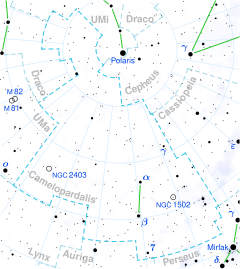8 Camelopardalis is a star in the northern circumpolar constellation of Camelopardalis.[7] It is a challenge to view with the naked eye, appearing as a dim, orange-hued star with an apparent visual magnitude of 6.09.[2] Based upon parallax, it is located around 750 light years away from the Sun.[1] At that distance, the visual magnitude is diminished by an extinction of 0.58 due to interstellar dust.[8]
| Observation data Epoch J2000.0 Equinox J2000.0 | |
|---|---|
| Constellation | Camelopardalis |
| Right ascension | 04h 59m 46.32836s[1] |
| Declination | +53° 09′ 19.6253″[1] |
| Apparent magnitude (V) | 6.09[2] |
| Characteristics | |
| Evolutionary stage | giant[3] |
| Spectral type | K4 III[4] |
| B−V color index | 1.462±0.009[2] |
| Astrometry | |
| Radial velocity (Rv) | −0.01±0.13[1] km/s |
| Proper motion (μ) | RA: −13.532[1] mas/yr Dec.: −10.700[1] mas/yr |
| Parallax (π) | 4.3709 ± 0.0613 mas[1] |
| Distance | 750 ± 10 ly (229 ± 3 pc) |
| Absolute magnitude (MV) | −0.11[2] |
| Details | |
| Mass | 1.13[5] M☉ |
| Radius | 30.19±3.31[3] R☉ |
| Luminosity | 341±6[1] L☉ |
| Surface gravity (log g) | 2.8[3] cgs |
| Temperature | 4,257+978 −190[1] K |
| Metallicity [Fe/H] | +0.06[3] dex |
| Rotational velocity (v sin i) | 1.6[6] km/s |
| Other designations | |
| Database references | |
| SIMBAD | data |
This is an aging K-type giant star with a stellar classification of K4 III,[4] which indicates it has exhausted the hydrogen at its core and evolved away from the main sequence. The star has expanded to 30[3] times the radius of the Sun and is radiating 341[1] times the Sun's luminosity from its enlarged photosphere at an effective temperature of 4,257 K.[1]
References
edit- ^ a b c d e f g h i j k Brown, A. G. A.; et al. (Gaia collaboration) (August 2018). "Gaia Data Release 2: Summary of the contents and survey properties". Astronomy & Astrophysics. 616. A1. arXiv:1804.09365. Bibcode:2018A&A...616A...1G. doi:10.1051/0004-6361/201833051. Gaia DR2 record for this source at VizieR.
- ^ a b c d Anderson, E.; Francis, Ch. (2012), "XHIP: An extended hipparcos compilation", Astronomy Letters, 38 (5): 331, arXiv:1108.4971, Bibcode:2012AstL...38..331A, doi:10.1134/S1063773712050015, S2CID 119257644.
- ^ a b c d e Baines, Ellyn K.; et al. (September 2016), "Spectroscopic and Interferometric Measurements of Nine K Giant Stars", The Astronomical Journal, 152 (3): 8, arXiv:1609.02379, Bibcode:2016AJ....152...66B, doi:10.3847/0004-6256/152/3/66, S2CID 52904703, 66.
- ^ a b Appenzeller, Immo (April 1967), "MK Spectral Types for 185 Bright Stars", Publications of the Astronomical Society of the Pacific, 79 (467): 102, Bibcode:1967PASP...79..102A, doi:10.1086/128449.
- ^ Anders, F.; Khalatyan, A.; Chiappini, C.; Queiroz, A. B.; Santiago, B. X.; Jordi, C.; Girardi, L.; Brown, A. G. A.; Matijevič, G.; Monari, G.; Cantat-Gaudin, T.; Weiler, M.; Khan, S.; Miglio, A.; Carrillo, I.; Romero-Gómez, M.; Minchev, I.; De Jong, R. S.; Antoja, T.; Ramos, P.; Steinmetz, M.; Enke, H. (2019), "Photo-astrometric distances, extinctions, and astrophysical parameters for Gaia DR2 stars brighter than G = 18", Astronomy and Astrophysics, 628: A94, arXiv:1904.11302, Bibcode:2019A&A...628A..94A, doi:10.1051/0004-6361/201935765, S2CID 131780028.
- ^ De Medeiros, J. R.; et al. (November 2000), "Rotation and lithium in single giant stars", Astronomy and Astrophysics, 363: 239–243, arXiv:astro-ph/0010273, Bibcode:2000A&A...363..239D.
- ^ a b "8 Cam". SIMBAD. Centre de données astronomiques de Strasbourg. Retrieved 2019-04-15.
- ^ Famaey, B.; et al. (January 2005), "Local kinematics of K and M giants from CORAVEL/Hipparcos/Tycho-2 data. Revisiting the concept of superclusters", Astronomy and Astrophysics, 430 (1): 165–186, arXiv:astro-ph/0409579, Bibcode:2005A&A...430..165F, doi:10.1051/0004-6361:20041272, S2CID 17804304.
